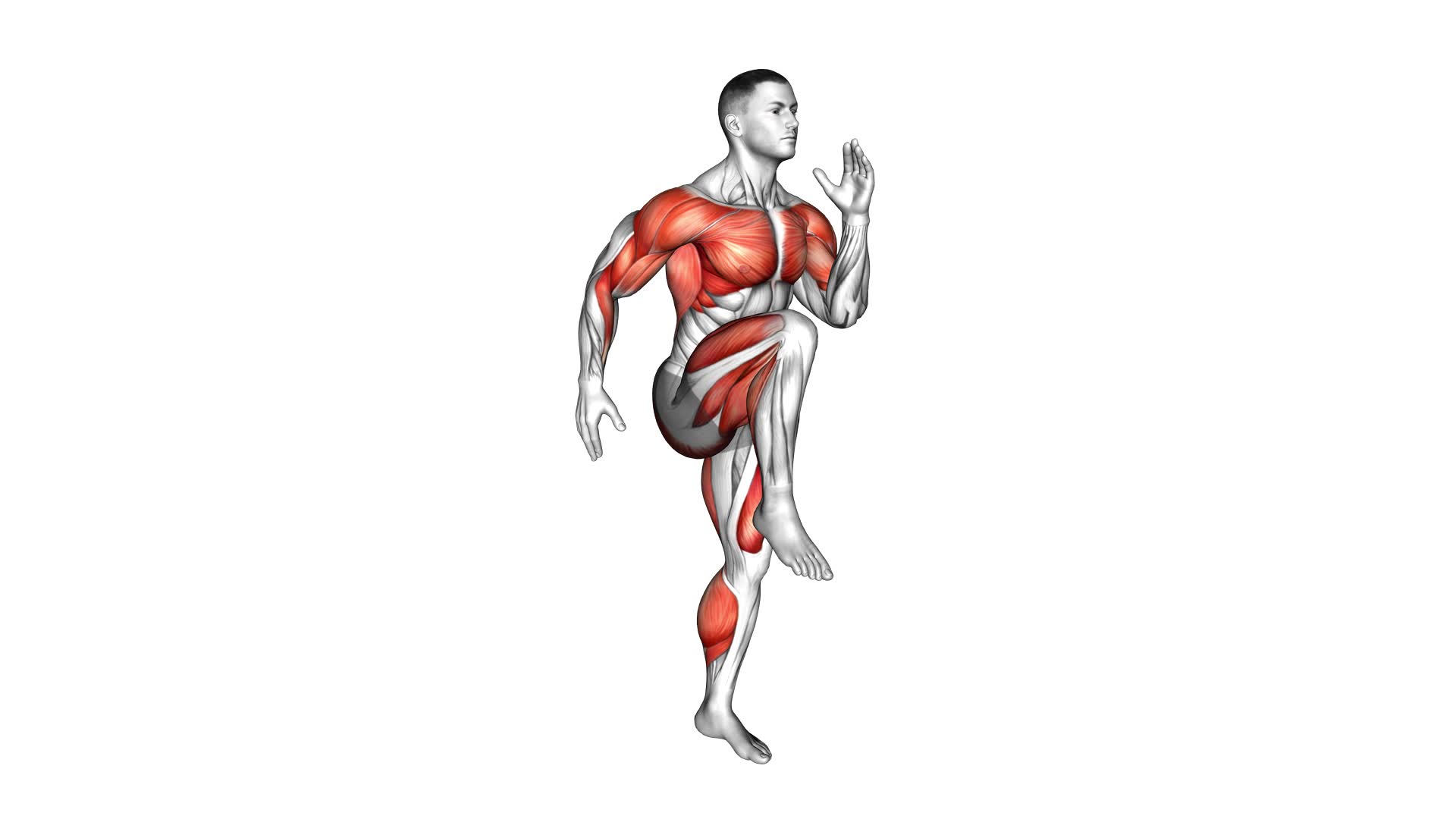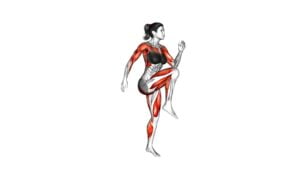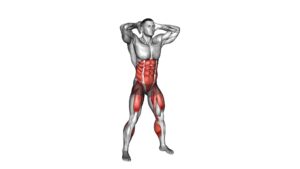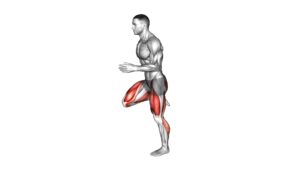High Knee Sprints – Video Exercise Guide & Tips

Get ready to take your workouts to the next level with high knee sprints!
Watch This Exercise Video
In this video exercise guide, we'll show you the proper form and technique for performing this dynamic exercise.
With just a few simple modifications and progressions, you can maximize the benefits of high knee sprints and achieve your fitness goals faster.
So lace up your shoes, press play, and get ready to sweat!
Key Takeaways
- High knee sprints can improve cardiovascular fitness and leg strength.
- Proper form and technique include maintaining upright posture, lifting knees as high as possible, and engaging core, hip flexors, and glutes.
- Common technique mistakes to avoid include excessive bouncing or jerking motions, leaning back or arching the back, and landing heavily on the feet.
- Equipment and warm-up routine should include comfortable and breathable workout attire, supportive athletic shoes, and dynamic stretches and exercises like leg swings, walking lunges, and hip circles.
Benefits of High Knee Sprints
To maximize your workout and improve your overall fitness, incorporate high knee sprints into your routine. High knee sprints offer numerous benefits, including increased cardiovascular fitness and improved leg strength.
High knee sprints are a high-intensity exercise that engages multiple muscle groups, primarily focusing on your lower body. By performing this exercise regularly, you can significantly enhance your cardiovascular fitness. The fast-paced movement of running in place while lifting your knees high requires your heart to work harder to supply oxygen-rich blood to your muscles. This increased demand for oxygen strengthens your heart, leading to improved cardiovascular endurance.
Additionally, high knee sprints are excellent for developing leg strength. The vigorous motion of lifting your knees to waist height engages your quadriceps, hamstrings, and glutes. These muscles are responsible for generating power and propelling you forward during various physical activities. By regularly incorporating high knee sprints into your routine, you can strengthen these muscle groups, leading to increased leg strength and overall lower body stability.
Proper Form and Technique
To ensure proper form and technique during high knee sprints, there are a few essential tips to keep in mind.
First, maintain an upright posture with your core engaged and shoulders relaxed.
Secondly, focus on lifting your knees as high as possible while driving your arms in a coordinated motion.
Lastly, avoid leaning forward or overstriding, as this can lead to inefficient movement and potential injury.
Essential Form Tips
Maintain a tall posture and engage your core while performing high knee sprints. This is essential for improving speed and avoiding injuries.
By keeping your body upright, you allow for optimal alignment, which helps you generate more power and move efficiently. Engaging your core muscles provides stability and support, reducing the risk of injury to your lower back and hips.
As you lift your knees, focus on driving them up towards your chest, rather than just lifting your feet off the ground. This will engage your hip flexors and activate your glutes, allowing for a more explosive movement.
Remember to maintain a quick and controlled pace, avoiding any excessive bouncing or jerking motions.
Common Technique Mistakes
Avoid excessive bouncing or jerking motions while performing high knee sprints. These movements can hinder your progress in improving speed and increase the risk of injury. Instead, focus on maintaining a fluid and controlled motion throughout the exercise. Keep your core engaged and your upper body stable while driving your knees up towards your chest. Avoid leaning back or arching your back, as this can lead to strain or discomfort.
Additionally, make sure to land softly on the balls of your feet to minimize impact and reduce the risk of injury. By practicing proper form and technique, you can maximize the benefits of high knee sprints while minimizing the chance of injury.
Transitioning into the next section, let's now discuss the equipment needed for high knee sprints.
Equipment Needed for High Knee Sprints
To perform high knee sprints effectively, you'll need minimal equipment. Here's what you need to get started:
- Workout attire: It's important to wear comfortable and breathable workout attire that allows for freedom of movement. Opt for moisture-wicking fabrics to keep you dry and comfortable throughout your high knee sprints. Choose a pair of supportive athletic shoes that provide cushioning and stability to protect your feet and ankles during the workout.
- Warm-up routine: Before diving into high knee sprints, it's crucial to warm up your body properly. Incorporate dynamic stretches and exercises that target your lower body, such as leg swings, walking lunges, and hip circles. This will help increase your range of motion, prepare your muscles for the intense sprinting motion, and reduce the risk of injury.
By wearing appropriate workout attire, you can ensure comfort and ease of movement during high knee sprints. Additionally, warming up properly will help prime your body for the workout and optimize your performance.
Common Mistakes to Avoid
Ensure that you have the right form and technique during high knee sprints by being mindful of these common mistakes. Proper form is crucial not only for preventing injuries but also for improving speed and agility.
One common mistake to avoid is leaning too far back while sprinting. This can put unnecessary strain on your lower back and decrease your overall speed. Instead, maintain an upright posture, engaging your core muscles to support your spine.
Another mistake is lifting your knees too high. While it's important to bring your knees up towards your chest, excessive height can lead to decreased speed and efficiency. Focus on lifting your knees to a comfortable height, ensuring that your thighs are parallel to the ground.
Additionally, avoid overstriding during high knee sprints. Overstriding occurs when you take excessively long strides, which can lead to decreased speed and increased risk of injury. Instead, aim for quick, short strides that allow for a faster turnover and maintain your balance.
Modifications and Progressions
To challenge yourself and make high knee sprints more difficult, incorporate advanced variations and intensified movements. Here are some modifications and advanced variations you can try:
Modifications:
- Increase the speed: Gradually increase your sprinting speed to challenge your cardiovascular endurance.
- Add resistance: Wear ankle weights or hold dumbbells while performing high knee sprints to increase the resistance and engage your muscles even more.
Advanced Variations:
- High knee skips: Instead of sprinting, skip with high knees, lifting your knees as high as possible with each skip.
- Double high knees: Perform two high knee steps with each leg before switching to the other leg. This increases the intensity and requires greater coordination and balance.
- High knee bounds: Bound forward with each step, propelling yourself off the ground using the power of your legs. This variation adds an explosive element to the exercise and targets your lower body muscles even more.
Remember to listen to your body and progress at a pace that feels challenging but manageable. Incorporating these modifications and advanced variations will help you take your high knee sprints to the next level and continue challenging your fitness levels.
Tips for Maximizing Your High Knee Sprints Workouts
To maximize your high knee sprints workouts, it's essential to focus on proper form techniques. Ensure that you're lifting your knees as high as possible with each stride and maintaining a strong core throughout the exercise.
Additionally, gradually increase the intensity levels by incorporating intervals, such as sprinting for a certain distance or time, and then recovering at a slower pace.
Proper Form Techniques
Maximize the effectiveness of your high knee sprints workouts with proper form techniques. To ensure injury prevention and enhance speed training, follow these tips:
- Maintain an upright posture: Keep your chest up and shoulders relaxed to engage your core and optimize your stride length.
- Drive your knees up: Lift your knees towards your chest as high as possible to activate your hip flexors and increase power and speed.
- Engage your arms: Pump your arms in sync with your leg movements to generate momentum and maintain balance.
- Land softly on the balls of your feet: Avoid heel striking to reduce the risk of joint injuries and improve energy transfer.
By focusing on these form techniques, you can maximize the benefits of your high knee sprints workouts and enhance your overall performance.
Now, let's explore how to increase the intensity levels for even greater results.
Increasing Intensity Levels
To increase the intensity of your high knee sprints workouts and maximize your results, incorporate these tips for maximizing your high knee sprints workouts.
One way to increase the difficulty is by adjusting the speed of your sprints. Start with a moderate pace and gradually increase your speed as you progress.
Another way to challenge yourself is by adding resistance. You can do this by wearing ankle weights or using resistance bands around your ankles. This will engage your leg muscles even more and make the exercise more challenging.
Additionally, you can increase the duration of your sprints. Start with shorter intervals and gradually increase the time as you get stronger.
Remember to listen to your body and only increase the difficulty level when you feel ready.
Frequently Asked Questions
How Many Calories Can You Burn With High Knee Sprints?
When you do high knee sprints, you can burn a significant number of calories.
This exercise has a high impact on your cardiovascular health, helping to improve your heart and lung function.
High knee sprints are an effective way to increase your heart rate and engage multiple muscle groups, resulting in a higher calorie burn.
Incorporating high knee sprints into your workout routine can contribute to weight loss and overall fitness.
Can High Knee Sprints Help Improve Agility and Coordination?
High knee sprints are a great exercise for improving agility and coordination. By incorporating quick, explosive movements, you can enhance your ability to change direction and react swiftly.
The benefits of high knee sprints extend beyond agility and coordination. This exercise also helps to strengthen your lower body muscles, increase your cardiovascular endurance, and burn calories.
Is It Safe to Do High Knee Sprints if You Have Knee or Hip Injuries?
If you have knee or hip injuries, it's important to consider safety precautions before doing high knee sprints. These exercises can put stress on your joints, so modifications may be necessary.
It's always best to consult with a healthcare professional or physical therapist to determine if high knee sprints are safe for you. They can provide guidance on proper form, recommend modifications, and help prevent further injury.
How Often Should High Knee Sprints Be Incorporated Into a Workout Routine?
To get the most out of high knee sprints, it's important to know how often to incorporate them into your workout routine. The frequency of high knee sprints depends on your fitness level and goals.
These sprints provide a high-intensity cardiovascular workout that can improve endurance, burn calories, and strengthen your leg muscles. However, they can also be demanding on your joints, so it's essential to listen to your body and give yourself enough time to recover between sessions.
Can High Knee Sprints Be Done on Different Surfaces, Such as Grass or Pavement?
Yes, high knee sprints can be done on different surfaces like grass or pavement. The surface you choose will affect the intensity and impact on your joints. Grass provides a softer landing, reducing the risk of injury. Pavement offers a more challenging and intense workout.
Additionally, high knee sprints can be modified to suit different fitness levels. Beginners can start with slower, controlled movements, while advanced individuals can increase speed and intensity.
Conclusion
In conclusion, high knee sprints are a beneficial exercise for improving cardiovascular fitness, leg strength, and overall speed.
By maintaining proper form and technique, using the right equipment, and avoiding common mistakes, you can maximize the effectiveness of your workouts.
Additionally, there are modifications and progressions available to suit various fitness levels.
Incorporate these tips into your high knee sprints routine to achieve optimal results.

Author
Years ago, the spark of my life’s passion ignited in my mind the moment I stepped into the local gym for the first time. The inaugural bead of perspiration, the initial endeavor, the very first surge of endorphins, and a sense of pride that washed over me post-workout marked the beginning of my deep-seated interest in strength sports, fitness, and sports nutrition. This very curiosity blossomed rapidly into a profound fascination, propelling me to earn a Master’s degree in Physical Education from the Academy of Physical Education in Krakow, followed by a Sports Manager diploma from the Jagiellonian University. My journey of growth led me to gain more specialized qualifications, such as being a certified personal trainer with a focus on sports dietetics, a lifeguard, and an instructor for wellness and corrective gymnastics. Theoretical knowledge paired seamlessly with practical experience, reinforcing my belief that the transformation of individuals under my guidance was also a reflection of my personal growth. This belief holds true even today. Each day, I strive to push the boundaries and explore new realms. These realms gently elevate me to greater heights. The unique combination of passion for my field and the continuous quest for growth fuels my drive to break new ground.







